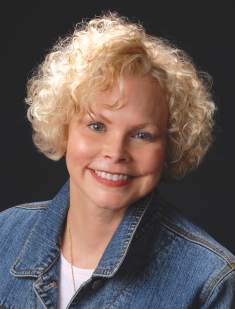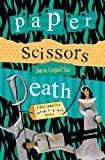 I love it when I come across a genre niche I’ve never heard of and I love it even more when I find a writer as savvy in marketing as he or she is in writing. I found both in Joanna Campbell Slan and her debut novel Paper, Scissors, Death. This was my first introduction to the ‘craft cozy’ mystery genre and though talk of scrapbooking and other activities that an already overworked woman and mother ‘should’ partake in normally turn me cold, this was strangely compelling. However, if I’m honest, my interest is more to do with the business and craft of writing than in scrapbooking or ‘cozy’ mysteries. But hey, that’s me; as Joanna shows, there are millions of readers out there who will lap this up. Go for it Joanna!
I love it when I come across a genre niche I’ve never heard of and I love it even more when I find a writer as savvy in marketing as he or she is in writing. I found both in Joanna Campbell Slan and her debut novel Paper, Scissors, Death. This was my first introduction to the ‘craft cozy’ mystery genre and though talk of scrapbooking and other activities that an already overworked woman and mother ‘should’ partake in normally turn me cold, this was strangely compelling. However, if I’m honest, my interest is more to do with the business and craft of writing than in scrapbooking or ‘cozy’ mysteries. But hey, that’s me; as Joanna shows, there are millions of readers out there who will lap this up. Go for it Joanna!
TCW: You mentioned that there is a growing niche market for fiction aimed at crafters in the US. Could you expand on that? Is it just limited to mysteries or are other genre represented too?
JCS: I’ve been told that craft cozies are flying off the shelves in US bookstores. The reason is simple: there are more crafters than readers of mysteries here in the States. This offers a huge growth market. Since the bulk of marketing and promoting is the author’s responsibility, it’s very effective to target a secondary niche market such as crafters.
TCW: Were you aware of this market before you wrote Paper Scissors Death or did you just write a mystery and then slot it into a market?
JCS: I knew that to break into the world of fiction I had to give a publisher a compelling reason to look hard at me—and a great manuscript is only part of that offering. Terrific books get turned down by agents and by editors every day. I knew scrapbooking inside and out, having written seven “how to” books on the topic. So I spotted that “hole” in the market, a place where I could take my experience and shine.(BTW, Joanna is already an established non-fiction writer – TCW).
TCW: Did you get an agent or did you send your manuscript directly to a publisher?
JCS: I pitched my book to my agent, and then I walked right over to pitch it to my acquiring editor. (I was at a writer’s conference that I’d attended expressly to do these pitches.) First the agent said, “Yes,” and then the editor did, too.
TCW: How has your background in scrapbooking helped you in marketing and promoting the book?
 JCS: Of course, my knowledge of that special niche – scrapbooking – with so many potential readers is important, but also my contacts in the industry, my understanding of how the industry works, my relationships with vendors who can open doors for me, my reputation with reviewers and industry publications, and my knowledge of the craft are all of value to my publisher. And I have a fabulous publisher Midnight Ink who really believes in me and gives my promotional suggestions consideration.
JCS: Of course, my knowledge of that special niche – scrapbooking – with so many potential readers is important, but also my contacts in the industry, my understanding of how the industry works, my relationships with vendors who can open doors for me, my reputation with reviewers and industry publications, and my knowledge of the craft are all of value to my publisher. And I have a fabulous publisher Midnight Ink who really believes in me and gives my promotional suggestions consideration.
TCW: Did you mention this as a USP when approaching publishers?
JCS: Absolutely. I included a marketing plan in my book proposal. After all, if given the choice between two authors – say, you have one who is willing, able, and dedicated to promoting her own work, and one you have to teach about the process – which one would you choose?
TCW: For those who haven’t read the book yet, there are non-fiction style elements included in the narrative as nearly every chapter ends with a scrapbooking tip list. Is this characteristic of ‘craft cozy’ fiction?
JCS: There are six sets of craft tips at the end of chapters, and 43 chapters, plus a prologue and epilogue. Including tips or techniques or patterns is characteristic of craft cozies. (And most scrapbookers would say there aren’t enough tips!)
TCW: I must say, as a non-scrapbooker, I found myself skipping those sections to get back to the ‘real’ story. Did you realise this might be a danger with promoting the book outside the scrapbook ‘ghetto’?
JCS: As a writer of this series, I straddle the two worlds: scrapbooking and non-scrapbooking. My goal is to write books interesting and rich enough to appeal to non-crafters. My litmus test is readers like you. I want scrapbooking – and the tips to be laignaippe. My fundamental philosophy is “always add value.”
TCW: How much of the ethos behind writing the book is evangelistic in the sense of trying to ‘convert’ readers to scrapbooking?
JCS: None. I love scrapbooking, and perhaps after learning more about it, a reader might decide to give it a go. But that isn’t my goal. I am simply being true to my character, who is overly-enthusiastic about the hobby. If I had portrayed her as anything else, she would not be who she is.
TCW: There is some fairly overt product placement in the book. Again, is this characteristic of craft cozy fiction? Do the named products and services pay for inclusion? Do they contribute towards publication costs? Or do they simply buy ad space?
JCS: I wrote the book using product names for credibility’s sake. They are somewhat of a code that tells scrapbookers, yes, the author really does scrapbook. When I say, “She’s not the sharpest craft knife in the Cropper Hopper,” any scrapbooker would chuckle and know EXACTLY what I mean. No one paid for inclusion.
TCW: Some writers would see this as selling out your editorial independence and artistic integrity. Others would see it as a realistic approach to finding commercial partners to help publish work. What can you contribute to this debate?
JCS: I would never sacrifice my integrity or my story for the sake of inclusion. However, given the choice between purposely not including names, and including them, why not? Isn’t avoiding inclusion a type of selling out? After all, you are letting an outside force determine what you write. You are “writing around” (that’s what we called it in journalism school) the brand. That can strain credulity as much as over-inclusion.
TCW: At the end of the book, you keep the door open for a sequel or even a series. Did you consciously set out to do this or was this a decision made with your publisher after they accepted your manuscript?
JCS: I pitched the publisher on writing a series. I loved the characters, believed they could grow, and that I would be happy spending time with them.
TCW: Do you think you may try your hand at other genre in the future? If so, which?
JCS: I still love non-fiction, and I’d like to write something with a historical bent. I am a writer. That’s what I do. That’s who I am. That’s how I process the world. I just love to write. I’ve worn the letters off my keyboard. I can’t imagine a day without writing … it’s too bleak.
TCW: If writers would like to explore the craft cozy fiction market further, can you recommend any websites or other resources?
JCS: I suggest they visit my website. They can also check out the blog I share with other authors of craft cozies – killerhobbies.blogspot.com.
TCW: Thanks Joanna! Happy writing.

Pingback: Incurable Disease of Writing » Blog Archive » Just Write Blog Carnival November 7, 2008 Edition
Pingback: Craft Cozies Come To Morgan Hill’s BookSmart | Aahz Reviews Morgan Hill
A very clever and interesting spin on the murder/mystery genre!